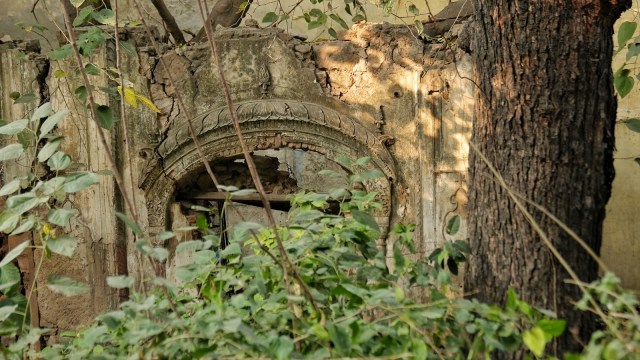In Mehrauli, a Mughal-sponsored temple is a testament to Delhi’s syncretic roots
A noble in the court of Mughal Emperor Akbar II by the name of Lala Sidhu Mal built the temple between 1806 and 1837.
 A now-abandoned part of Yogmaya Temple. (Express Photo by Abhinav Saha)
A now-abandoned part of Yogmaya Temple. (Express Photo by Abhinav Saha)From a Mughal-sponsored structure to a concrete building, the Yogmaya Temple in Mehrauli is a historically important monument believed to be standing at the site of an ancient temple that is said to have come up during the period of the Mahabharata but of which no trace exists anymore.
A noble in the court of Mughal Emperor Akbar II by the name of Lala Sidhu Mal built the temple between 1806 and 1837. The area was known as Yoginipura in ancient Jain texts and Prithviraj Chauhan himself was said to have patronised a Yogini temple here shortly before his city’s destruction. Lala Sidhu Mal, also known as Sed Mal, built his temple on the site where an ancient Yogini Temple is believed to have existed.
Today, parts of the structure built in the 1800s can be seen on the site of the temple before it was renovated in the 1960s. It now stands as a dilapidated building, with the walls of the structure worn out and full of cracks, and paint peeling off.
Author and historian Sam Dalrymple told The Indian Express, “Zafar Hasan’s book Monuments of Delhi talks about it as fully intact in 1920 and said in his books that it was one of the best-preserved sites in Delhi … Something curious which you find it in almost all of UP, Haryana and Delhi is the idea that there are no historical mandirs in the area and they were all destroyed by Muslim rule. This, of course, isn’t true because they were constantly renovated. You have got loads of historic documented temples from this time, there are 200 in Delhi alone and almost all of them have been renovated because they are all made of brick and in this area.”
He added, “Outside of Rajasthan and in North India you don’t have much stone. So, only imperial monuments could afford sandstone and most of them afford brick and limewash. Now, over 200 years, this needs to be renovated and about 95% of the people in charge of these temples in the 1960s simply chose not to continue the expensive use of limewash and brick and decided to change to concrete instead.”
Taking to Instagram recently, Dalrymple wrote, “When we visited, we spotted late Mughal columns being used to cover a sewer. You get the feeling that in any other country these historic objects would be worth thousands of dollars, but here they are left to decay … Sadly, today it has been completely renovated so that the Mughal structures have been entirely erased … All that remains of the historic temple today is a small baradari, two shivalaya-like structures, and some decrepit late Mughal walls.”
He added that the Yogmaya temple was a focal point of Akbar II’s rule. “When his son was released from British prison in Allahabad, the emperor’s wife offered a chador of flowers at the Qutubuddin Dargah. The Emperor himself ordered a similar offering to be given at Yogmaya. Placing flowers at both holy sites became a yearly tradition known as Phool Walon ki Sair, and it continues to this day as the capital’s most prominent display of Hindu-Muslim unity.”
The Yogmaya temple, Dalrymple said, was not particularly exceptional as a temple sponsored by a Mughal nobleman and was “given patronage by a Mughal Emperor”. “Akbar II for a lot of his life was under the patronage of the Scindias … the Marathas were the protectors of the Mughals at this point during Shah Alam’s reign,” he said.
Author Swapna Liddle told The Indian Express, “Periodically, people keep making changes and expanding temples. There is a clear distinction between temples and the buildings at the site of the temples. Yogmaya was a very ancient temple, which was born much earlier … The building might be from the 19th-century from a historian’s point of view but the temple on the site was born much earlier.”
Authors Jitender Gill and Namita Sethi wrote in their book In Search of Delhi: A Translation of Brij Kishan Chandiwala’s Dilli Ki Khoj, “There is a tale in the Bhagawat about the birth of Lord Krishna that he was able to escape the clutches of Kamsa with the help of Yogmaya. It is likely the Pandavas had this temple built in the memory of the same … ”
Author-historian Rana Safvi wrote in her book Where Stones Speak: Historical Trails in Mehrauli, the first city of Delhi: “….This is said to be one of the five temples, which remain from the Mahabharata period and was made by Yudhishtir … In his Reminiscences of Imperial Delhi, Thomas Metcalfe, the governor general’s agent in Delhi (1844) mentions the building of the shrine of Yogmaya during the reign of Akbar II (r.1806-1837) at the site of an ancient temple of which no trace survives.”







